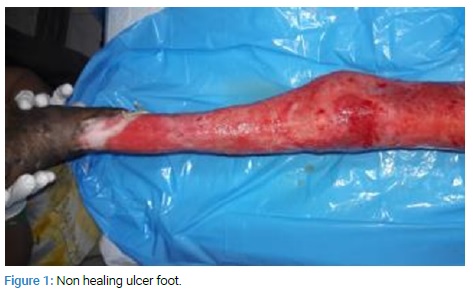Abstract
Wound healing is a complex process with steps of haemostasis, the inflammatory and proliferative phases, remodelling. The difficulties in the edge of the wound can be detrimental to healing and may cause a delay in wound healing. Sucralfate has been used in gastric and duodenal ulcers. Studies have shown a beneficial effect on skin lesions, dermatitis, and burns. In this article, we share our experience of using sucralfate in the case of a non healing ulcer.
Introduction
Wound bed preparation is done using the T.I.M.E concept. The Edge involves granulation tissue for better healing. Recently we have come across the application of topical sucralfate therapy for the management of non-healing ulcer, and we share our experience.
Material and Methods
This study was conducted in the department of Plastic Surgery at tertiary care center after obtaining the departmental ethical committee approval. Informed consent was taken from patient in study. The details of the patient in study are as given: 37-year-old female with no known co-morbidities with history of road traffic accident 4 months back and below knee amputation done due to vascular injury and degloving injury of the left lower limb for which debridement was done in cardiothoracic and general surgery department. Now, the patient presented to plastic surgery department with extensive raw area over the left lower limb. After debridement of the wound, sucralfate cream (Figure 1 and 2) was applied on the wound. Over that a non-adherent dressing was placed, and dressing was given. Repeat debridement was done if necessary and sucralfate was applied and the dressing was given. Eight such sessions of sucralfate application were done over four weeks.


Results
The wound showed healing as evidenced by healthy granulation tissue and allowed for skin grafting to be done (Figure 3).

Discussion
Wound bed preparation was redefined as the global management of the wound to accelerate endogenous healing or to facilitate the effectiveness of other therapeutic measures. Wound bed preparation can be summarized by the acronym T.I.M.E with T for tissue: non-viable or deficient. I for infection/inflammation, M for moisture balance. E for epidermis which was later changed to E for edge. Debridement, control of inflammation as well as moisture are essential parts of wound bed preparation that may cause the edge of the wound to migrate closer, but if they fail, other therapies may be required. Many therapeutic methods are available to cause the wound healing like the topical application of insulin, growth factors, negative pressure assisted wound closure, oxidized regenerated cellulose/collagen, hyaluronic acid conjugated with glycidyl methacrylate or gelatin dressings. Sucralfate is aluminum hydroxide salt of disaccharide sucrose octasulfate. The role of sucralfate in gastric and duodenal ulcers is established. It coats the ulcer and forms a mucus gel which binds to the bile acids. The role of sucralfate in several other ulcerative lesions has been studied. In some studies it is found that it helps in healing of chronic venous ulcers [1,2]. It has been shown that sucralfate increases the rate of epithelialization and promotes the formation of healthy granulation tissue in second and third-degree burns [3–5]. It prevents and helps in the healing of radiation-induced ulcers [6]. The mechanism of action of sucralfate in wound healing is multifactorial. Sucralfate increases the bioavailability of growth factors and prostaglandins and decrease the production of oxygen free radical synthesis, thus potentiating angiogenesis, granulation tissue, as well as reepithelialization. It also increases the bioavailability of growth factors, particularly of FGF. It increases the formation of prostaglandins and inhibits oxygen free-radicals [5]. Ala S. et al. [6] found no effect of sucralfate in the healing of pressure ulcers. In our case, we have used sucralfate cream as adjunct to other measures in the case of the non healing ulcer. No adverse effect was noted with its application.
Conclusion
Topical sucralfate therapy was found to be helpful in management of non-healing ulcer as it causes improvement of the granulation tissue. Long-term clinical observations are needed to determine whether topical sucralfate can be used for wound bed preparation.
Keywords
Topical sucralfate; Non healing ulcer
Cite this article
Thomas N, Chittoria RK, Gupta S, Reddy LC, Mohan PB, Pathan I, et al. Role of topical sucralfate therapy in non healing ulcer. Clin Surg J. 2020;1(5):1–2.
Copyright
© 2020 Ravi Kumar Chittoria. This is an open access article distributed under the terms of the Creative Commons Attribution 4.0 International License (CC BY-4.0).



